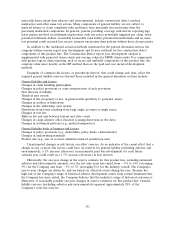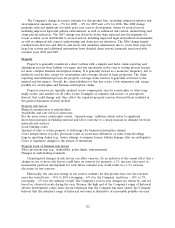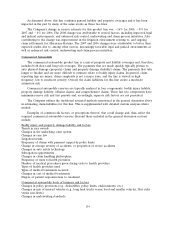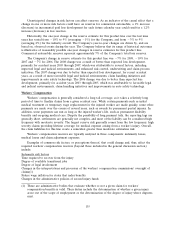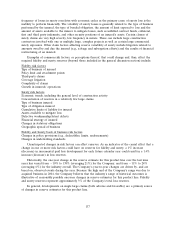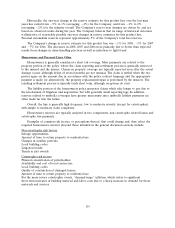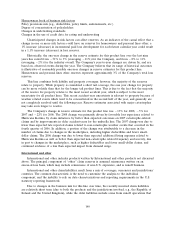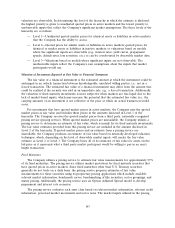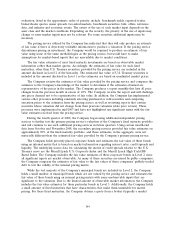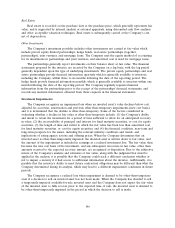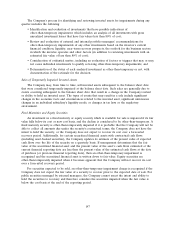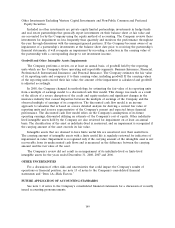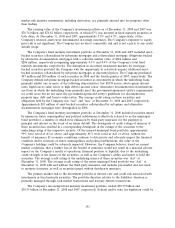Travelers 2008 Annual Report Download - page 153
Download and view the complete annual report
Please find page 153 of the 2008 Travelers annual report below. You can navigate through the pages in the report by either clicking on the pages listed below, or by using the keyword search tool below to find specific information within the annual report.
are extremely long tail (e.g., U.S. excess liabilities reinsured through the London market, and several
underwriting pools in runoff). The speed of claim reporting and claim settlement is a function of the
specific coverage provided, the jurisdiction, the distribution system (e.g., underwriting pool versus
direct) and the proximity of the insurance sale to the insured hazard (e.g., insured and insurer located
in different countries). In particular, liabilities arising from the underwriting pools in runoff may result
in significant reporting lags, settlement lags and claim complexity, due to the need to coordinate with
other pool members or co-insurers through a broker or lead-insurer for claim settlement purposes.
International and other reserves are generally analyzed by program/pool, country and general
coverage category (e.g., U.S. Liability—excess of loss reinsurance, or General Liability—
Municipalities—by country). The business is also generally split by direct versus assumed reinsurance
for a given coverage/jurisdiction. Where the underlying insured hazard is outside the United States, the
underlying coverages are generally similar to those described under the General Liability and
Automobile discussion above, but under a different legal system. Where the underlying hazard is within
the U.S., the coverage involved is typically that of General Liability, but on an excess or excess-of-loss
reinsurance basis. Excess exposure requires the insured to ‘‘prove’’ not only claims under the policy, but
also the prior payment of claims reaching up to the excess policy’s attachment point.
Examples of common risk factors, or perceptions thereof, that could change and, thus, affect the
required International and other reserves (beyond those included in the general discussion section)
include:
International and other risk factors
Changes in claim handling procedures, including those of the primary carriers
Changes in policy provisions or court interpretation of such provision
New theories of liability
Trends in jury awards
Changes in the propensity to sue
Changes in statutes of limitations
Changes in the underlying court system
Distortions from losses resulting from large single accounts or single issues
Changes in tort law
Changes in claim adjuster office structure (causing distortions in the data)
International and other book of business risk factors
Changes in policy provisions (e.g., deductibles, policy limits, endorsements, ‘‘claims-made’’ language)
Changes in underwriting standards
Product mix (e.g., size of account, industries insured, jurisdiction mix)
Unanticipated changes in risk factors can affect reserves. As an indicator of the causal effect that a
change in one or more risk factors could have on reserves for International and other (excluding
asbestos and environmental), a 1% increase (decrease) in incremental paid loss development for each
future calendar year could result in a 1.3% increase (decrease) in loss reserves. International and other
reserves (excluding asbestos and environmental) represent approximately 7% of the Company’s total
loss reserves.
International and other represents a combination of different product lines, some of which are in
runoff. Comparative historical information is not available for international product lines as insurers
domiciled outside of the U.S. do not file U.S. statutory reports. Comparative historical information on
runoff business is not indicative of reasonably possible one-year changes in the reserve estimate for this
mix of runoff business. Accordingly, the Company has not included comparative analyses for
International and other.
141


